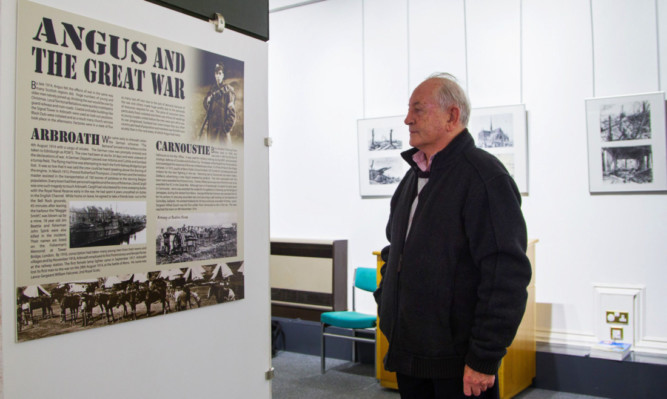It was the day German sailors came to Arbroath without knowing they were at war.
German schooner the Behrend arrived at the harbour on August 4 1914 and its crew were promptly arrested.
They had arrived with a cargo of oilcake unaware after 24 days at sea that war had been declared by Britain that day.
This and many other tales of intrigue and heroism which took place during First World War Angus have been recounted in an exhibition that is taking the county by storm.
Produced by Angus Council’s galleries unit, the exhibition has been touring museums to commemorate the war’s centenary, and is now resident in Arbroath Library until April 11.
Galleries curator Jim Boon said: “The display has already been in Brechin Town House Museum and the Meffan in Forfar.
“With the help of audio-visual presentations and informative display panels, the story of the Great War is clearly explained with reference to the role Angus played in the conflict.
“The exhibition includes a selection of objects from the Angus Council museums collection and includes the impressive painting Backs to the Wall by renowned military artist Robert Gibb RSA.
Field Marshal Douglas Haig issued the order that “every position must be held to the last man” as British positions looked tenuous ahead of the United States’ entry into the war.
That story is among a plethora of others in the exhibition from across every burgh in Angus, including the following:
l Arbroath A German zeppelin bombed an Arbirlot turnip field after it got lost trying to find the Forth Bridge; David Cargill, who spent the first four years of war with Royal Navy Reserve minesweepers unscathed, was killed by a mine on a fishing trip to the Bell Rock along with two friends.
l Brechin The Earl of Dalhousie was injured during the first Battle of Ypres in December 1914 and was carried back to safety by his valet GH Tait; Brechin’s first casualty was Corporal William Dunn, who was shot by a sniper as he dug trenches on January 23 1915.
l Carnoustie Barry Buddon provided an important artillery training ground during the war; 21 of 24 men in Westhaven enlisted in the early fighting; Charles Jarvis and George Samson were awarded the Victoria Cross; Sergeant Alfred Gooch was Carnoustie’s first soldier to die in the war, with news reaching town on November 4 1914.
l Forfar Bridie production was stopped for a short time in 1917 due to flour shortages; Mons the Cat, which was rescued in Belgium, was brought to the town to live and was used as a promotional figure for wartime fundraising.
l Kirriemuir Private Charles Melvin was awarded the Victoria Cross for actions during the Battle of Istabulat, Mesopotamia; Lance Corporal John Beaton of 5th Battalion The Black Watch had poetry printed and sold at home to raise money for the troops; two of author Sir JM Barrie’s nephews were killed in the conflict and are commemorated on the St Andrew’s Church memorial in town.
l Monifieth JF Low Iron Foundry added a Louvrain shell factory to its site, producing 18lb shells, French howitzers, mines and tank parts; the Red Cross ran a hospital in the Gerard Hall.
l Montrose Artist William Lamb retrained to draw with his left hand after he sustained shrapnel wounds to his right; Lieutenant Angus Hughes Mearns was shot down by the Red Baron, Baron Von Richthofen, and his remains were never recovered; Montrose was the site of the first operational airfield in the UK.
